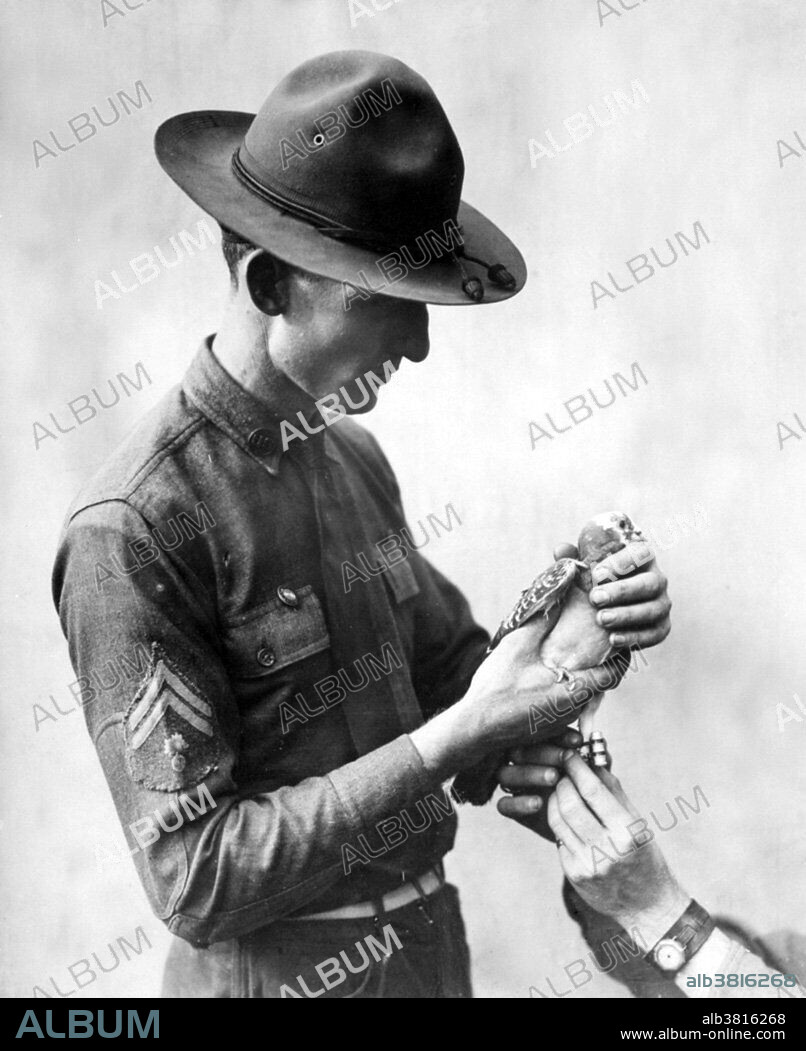alb3816268
WWI, U. S. Army Signal Corps Carrier Pigeon

|
Add to another lightbox |
|
Add to another lightbox |



Buy this image.
Select the use:

Title:
WWI, U. S. Army Signal Corps Carrier Pigeon
Caption:
Attaching a message to a Signal Corps carrier pigeon, circa 1917-18. A carrier pigeon is a homing pigeon (domesticated rock pigeon, Columba livia) that is used to carry messages. Before the advent of radio, carrier pigeons were frequently used on the battlefield as a means for a mobile force to communicate with a stationary headquarters. Historically, pigeons carried messages only one way, to their home. They had to be transported manually before another flight. However, by placing their food at one location and their home at another location, pigeons have been trained to fly back and forth up to twice a day reliably, covering round-trip flights up to 100 miles. During WWI, carrier pigeons were used to transport messages back to their home coop behind the lines. When they landed, wires in the coop would sound a bell or buzzer and a soldier of the Signal Corps would know a message had arrived. He would go to the coop, remove the message from the canister, and send it to its destination by telegraph, field phone, or personal messenger. A carrier pigeon's job was dangerous. Nearby enemy soldiers often tried to shoot down pigeons, knowing that released birds were carrying important messages. Using pigeons to carry messages is generally called, pigeon post.
Category:
black & white • History: Modern
Credit:
Album / NARA/Science Source
Releases:
Image size:
806 x 998 px | 2.3 MB
Print size:
6.8 x 8.4 cm | 2.7 x 3.3 in (300 dpi)
Keywords:
1ST WORLD WAR • 20 20TH XX XXTH TWENTIETH CENTURY • 20 XX TWENTIETH CENTURY • 20TH CENTURY • 20TH • ALLIED FORCES • AMERICAN • ANIMAL • ARMED FORCES • ARMIES ARMY • ARMIES • ARMY'S • ARMY • ATTACHING MESSAGE • AVES • BIRD • BIRDS • BLACK & WHITE • BW • CARRIER PIGEON • CELEBRITIES • CELEBRITY • COMMUNICATIONS • DOMESTICATED ROCK PIGEON • EVENT • EVENTS • FAMOUS PEOPLE • FAMOUS • FIRST WORLD WAR • GLOBAL WAR • GREAT WAR • GUERRA • HISTORIC • HISTORICAL • HISTORY • HISTORY: MODERN • HOMING PIGEON • HUNDRED YEARS WAR • I WORLD WAR • IMPORTANT • MALE • MAN • MEN • MESSENGER PIGEON • MESSENGER • MILITARY • NOTABLE • PHOTO • PHOTOGRAPH • PIGEON FANCIER • PIGEON HANDLER • PIGEON KEEPER • PIGEON POST • PIGEON TRAINER • PIGEON • SIGNAL CORPS • TWENTIETH CENTURY • UNITED STATES • US • USA • WAR PIGEON • WAR • WARFARE • WARS • WELL-KNOWN • WESTERN FRONT • WORLD WAR 1 • WORLD WAR I (1914-18) • WORLD WAR I • WORLD WAR ONE • WW1 • WWI
 Pinterest
Pinterest Twitter
Twitter Facebook
Facebook Copy link
Copy link Email
Email
